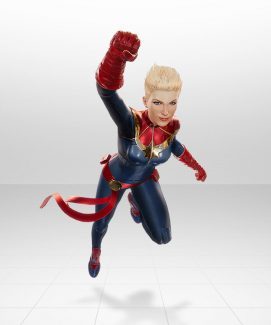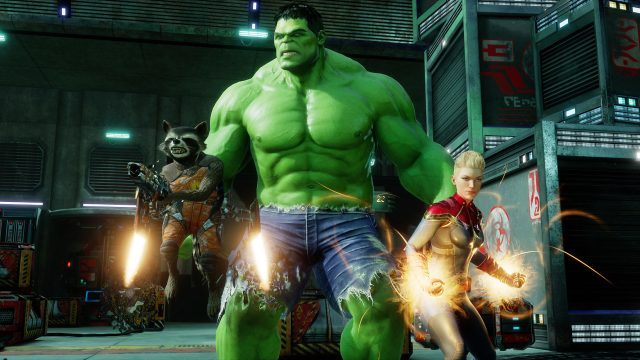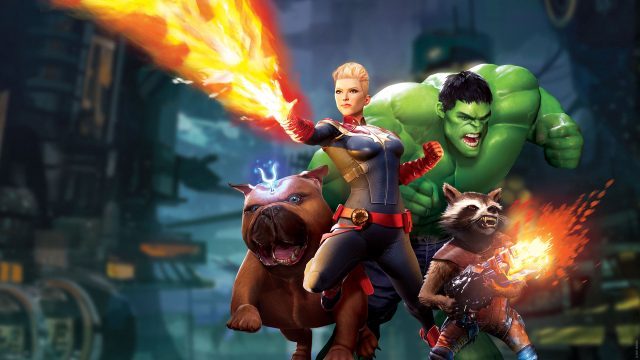Oculus has teamed up with developer Sanzaru Games (behind titles like VR Sports Challenge and Ripcoil) to bring the world of MARVEL to VR. Marvel Powers United VR is a four-player co-op focused experience that will let you step into the capes, claws, swords, and more, of 12 of the universe’s heroes. Here’s our first look at gameplay and hands-on impressions.
Marvel Powers United is all about bringing an authentic taste of the Marvel universe to VR. Marvel is said to be working closely with the developers to ensure a faithful representation for fans, all the way from original voice actors to officially sanctioned character models to lore-abiding superpowers and more. But will the game be more than just fan service? That’s the big question.
Our first hands-on time with the game came this week at an Oculus event in San Francisco. There I got to play a slice of the game with three others—the four of us embodying Hulk, Captain Marvel, Rocket Raccoon, and the newly announced Deadpool. All in all, the game’s roster will eventually include 12 heroes, though the others haven’t yet been announced. Each hero will have their own set of abilities which brings varied gameplay depending upon who you choose and what your team’s composition is.
Stepping into Captain Marvel’s shoes, I could shoot short bursts of energy from my hands using the trigger, aimed with a laser-like cursor that showed where I was pointing; holding down the trigger would charge the energy for a more powerful version of the basic attack. Holding the controller’s grip button would extend a pair of glowing energy shields from my hands which each had a bar that took several seconds to charge. Once charged, the energy from the shields could be discharged as a powerful continuous steam for a few seconds. Thanks to superhuman strength, I could also grab crates and other objects around the environment to throw at enemies.
I could also ‘fly’ using the A button on the controller which would blink me to a position 20 or so feet off the ground, and I could continue to move around at that height to get a better angle on foes below, or to fly easily up to platforms above ground level.
 With all ranged attacks and a flight ability to get me to a good vantage point, Captain Marvel is definitely a ranged character. That differs greatly from Hulk or Deadpool who use melee as a primary means of combat.
With all ranged attacks and a flight ability to get me to a good vantage point, Captain Marvel is definitely a ranged character. That differs greatly from Hulk or Deadpool who use melee as a primary means of combat.
With a launch date still far away in 2018, what I saw is definitely an early version of the game. That said, gameplay consisted mostly of the four of us running down rather uninspiring corridors, using our abilities to dispatch uninteresting enemies of arbitrary numbers. At the end of the 10 minute demo, we were met with a boss (Ronan) whom we attacked from a distance until his health bar went to zero.
Battling against bland enemies with three different power levels of the same simple point-and-shoot ranged attack, I can’t say I felt like a superhero, mostly because pointing and pulling the trigger repeatedly was all I was doing—no need to aim for weak spots, prioritize targets, dodge incoming fire, or to use one attack over the other. You could have replaced my energy blasts with guns instead and I wouldn’t have noticed. I found it more gratifying to grab crates and hurl them at enemies than to spam my basic ranged attack.
I Want to Feel Like a Superhero, Not Just Dress the Part
 From my discussion with the developers, much of the emphasis of Marvel Powers United is about making you feel like the given superhero. But for people who don’t have any special connection to the characters, gameplay will of course be the ultimate determinator of fun; I’m waiting (and hoping) for the game to make me feel truly super, which means being able to interact with the world in ways that are drastically different than the lore would allow for a ‘realistic’ VR FPS.
From my discussion with the developers, much of the emphasis of Marvel Powers United is about making you feel like the given superhero. But for people who don’t have any special connection to the characters, gameplay will of course be the ultimate determinator of fun; I’m waiting (and hoping) for the game to make me feel truly super, which means being able to interact with the world in ways that are drastically different than the lore would allow for a ‘realistic’ VR FPS.
In this vein, the game seems like it would benefit massively from deep environmental interaction. The world surrounding the players shouldn’t just be there to funnel us from A to B; I want to see the world like a superhero and exploit my powers (and the unique powers of VR) to manipulate the environment in extraordinary ways that don’t make sense in a simple shooter or melee game: let me punch the supports out from under a platform to send the enemies above toppling down; let my energy beam melt doors shut, or blow open walls to create new avenues for attack; let me expose rebar in the wall with my fists and then rip it out to use as a melee weapon; let me tear off a car door to use as a shield; and then let me throw it like a sharpened frisbee to cut a cable to drop debris on enemies—you know, badass superhero stuff.
For example, I feel much more like a superhero in Robo Recall: there I can grab enemies and rip off their limbs, then use the limb as a bat; I can catch enemy projectiles and throw them back with enough force to destroy them; I can throw an enemy high into the air and blast it to pieces; I can even repurpose each enemy as a unique weapon.
What can I do (from a gameplay standpoint) as a superhero do that a non-hero can’t? The answer is the experience that Marvel Powers United should seek to offer.
Experiments in Locomotion and Comfort
 Some of you reading this will notice I haven’t yet talked much about locomotion. Marvel Powers United is the first game under Oculus’ watch to feature stick-based locomotion, which the studio has previously shied away from due to comfort concerns. A developer working on the game told me that Oculus specifically asked Sanzaru to ‘push the boundaries’ of comfort and locomotion in VR, apparently in an effort to get away from the comfortable-but-not-particularly-immersive teleportation method which has been found in many other titles.
Some of you reading this will notice I haven’t yet talked much about locomotion. Marvel Powers United is the first game under Oculus’ watch to feature stick-based locomotion, which the studio has previously shied away from due to comfort concerns. A developer working on the game told me that Oculus specifically asked Sanzaru to ‘push the boundaries’ of comfort and locomotion in VR, apparently in an effort to get away from the comfortable-but-not-particularly-immersive teleportation method which has been found in many other titles.
In Marvel Powers United, you use the thumbstick on the Touch controller to move your character, very similar to a traditional FPS. The movement is relatively slow, and remained comfortable in my time with the game (even though I’m typically sensitive to this type of movement).
The game is also one of the first Oculus titles where you can look down and see your entire body (including your arms and feet) in the first-person view. The vast majority of VR games today show only floating hands with invisible arms, and no torso or other parts of the player’s body (again, for comfort reasons). This choice was of course to make the player feel like they really are the superhero in question.
In my case, I could see my red gloves, arms covered in a blue suit, and looking down I could see ‘my’ breasts, torso, legs, and feet. When you look down and move around it’s easy to feel disconnected as your feet move in VR despite being still in real-life; otherwise the fully modeled body didn’t bother me much.
The game also plays with scale quite effectively. If you are Hulk, you will feel like you’re huge. If you’re Rocket Racoon, you’ll feel tiny, and players will have to look down at you to talk to you.
It will be interesting to see if the remaining cast of superheroes can offer more varied gameplay through unique kits and abilities, and how they might take advantage of the varying scale and possibly unique locomotion opportunities *cough*Spider-man*cough*.






